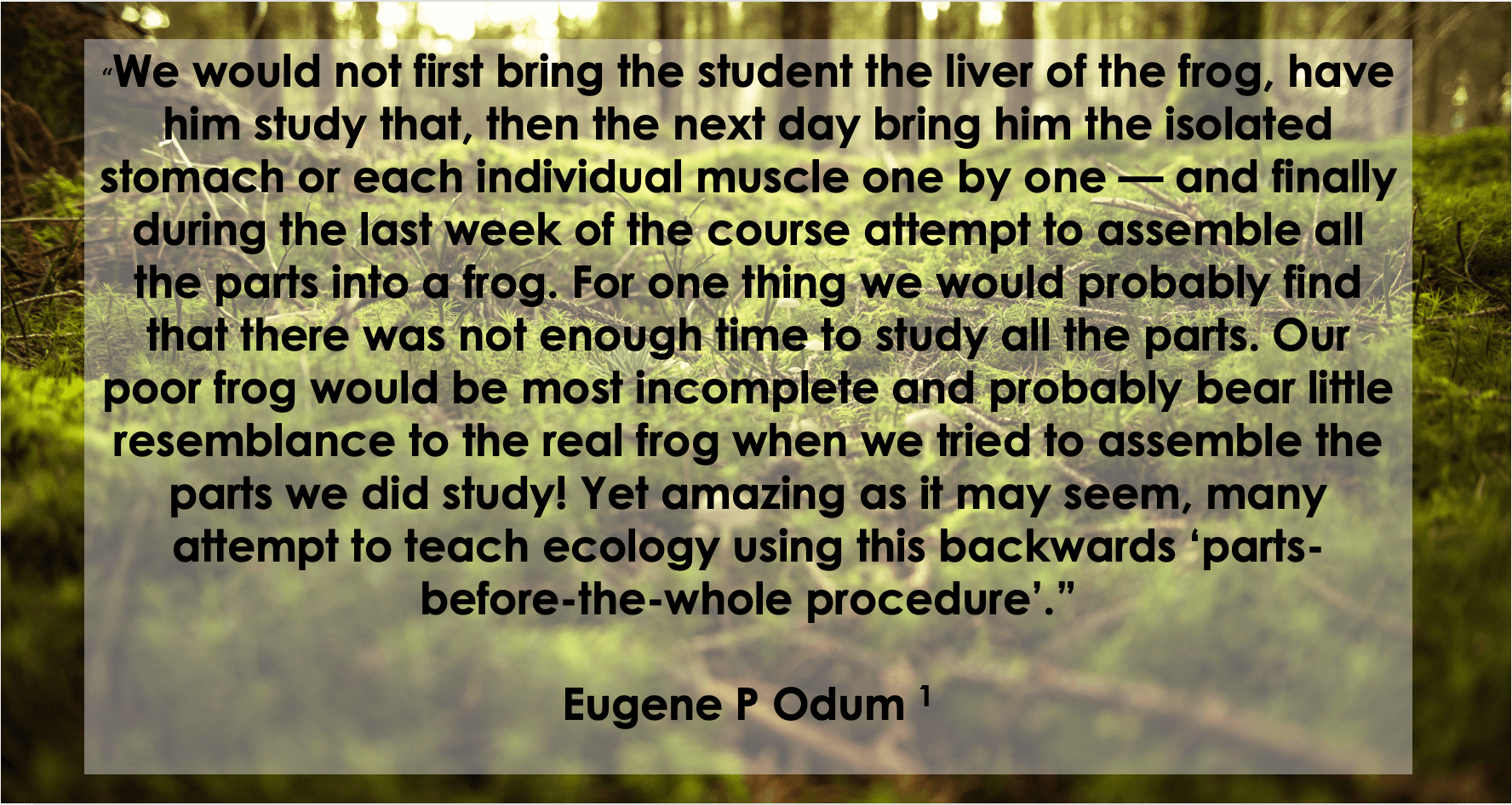By Daniel Maynard
Ecology is heading towards a crossroads. The past century of ecological research has provided amazing insight the into inner working of natural ecosystems, with much of this knowledge gleaned from carefully constructed experiments allowing scientists to isolate individual mechanisms at unprecedented detail. Yet, because of the societal demands being placed on the environmental sciences, our local- and micro-scale understanding of natural communities is now being asked to solve, within a relatively short time period, environmental problems that take place across enormous temporal scales.

This mismatch in scales creates a challenge for ecologists: much like Odum’s hypothetical frog, how can we hope to infer complex large-scale outcomes from incomplete local-scale knowledge? And, given the sheer complexity of natural ecosystems, how can we hope to assemble our bottom-up, mechanistic solution in a timely manner? Odum’s response would have likely been that we need to adopt a more holistic, top-down approach by reducing the complexity of an ecosystem to its core components and focus on the emergent broad-scale patterns. From an ecosystem perspective, these holistic approaches have indeed proved especially useful for studying elemental cycles and energy transfer through large landscapes, where the movement of an element (e.g., water) can adequately be modeled by relatively simple assumptions. Although such simplifications do not get things perfectly correct, they are close enough to allow for accurate and meaningful predictions.
But what about questions regarding so-called ‘biotic’ patterns and processes such as biodiversity patterns, invasive species, conservation hot-spots, biographical trade-offs, community stability, species coexistence, etc.? Obviously, we can’t expect to model global biodiversity, for example, by considering interactions between all pairs of species in the world (if for no other reason than a lack of computational power), so to some extent Odum’s holistic, top-down approach is a necessity. But the question remains: exactly how much complexity can we remove before our projections become uninformative? The answer, it seems, is less than we once would have thought. That is, it’s becoming increasingly clear that local-scale environmental variation and small-scale biotic processes (e.g. species interactions) are not just important, but are absolutely integral for understanding broad-scale ecological patterns. For example, predicting the impact and spread of a newly introduced invasive species requires an understanding of how this species interacts with each other species in its new environment. Thus, when trying to predict global patterns of ecosystem invasibility, one must first have a good understanding of the ecological mechanisms that insulate a community from invasion, and second, have a decent approximation of structure and composition of every ecosystem across the Earth.
Such questions are essentially questions about community ecology, re-framed at an enormous scale. Community ecology, being the sub-discipline addressing the abundance and distribution of species, is traditionally applied to relatively simple communities, often modeling interactions among a handful of species to make inference about a specific “local” community. In doing so, it is focused on identifying mechanisms that dictate the distribution of species – it has not, historically, focused on making and testing predictions about novel environments.
And yet, because of the urgency of human-induced global change, the next generation of community ecologists are going to have to do exactly this: take their metaphorical understanding of a frog’s stomach and liver (local scale ecological processes), and assemble a decent approximation of a frog (global scale patterns and processes). Because we will never be able to accurately predict the emergent properties of an ecosystem by modeling interactions at the level of the individual, doing so will require that we adopt of principle of ‘Odum’s razor’ to cut away necessary complexity that, although perhaps compelling and beautiful in its own right, provides negligible predictive power or insight. Many community ecologists (I include myself here) are driven by the desire to explain nuance and novelty in nature; but those of us interested in addressing global questions will have to fight this urge to focus solely on undocumented ecological phenomena. Instead, we need to identify a core set of rules that govern the basic structure of natural communities and which apply to every community on Earth –that is, we need to move towards a community view of global ecology.

Accomplishing this task doesn’t mean we curtail basic research in community ecology; we still need accurate local-scale understanding of important ecological processes. Moreover, even if we develop new theory and approaches for modeling broad-scale biotic processes, we can only make accurate projections if we have a good understand of which community processes are the dominant controls at the small scale. Thus, our ability to make broad-scale predictions depends on people doing local-scale science, and sharing their data to allow for broader questions. Individually, any single one provides little insight into global patterns, but collectively, our work can create a vast web ecological insight that allows us to glean clear trends that hold across systems and scales.
The debate over how to approach ecological questions is often framed through the idea of a bottom-up, mechanistic approach, versus a top-down, reductionist approach. But from a community ecology perspective this is something of a false paradigm: there is no broad-scale understanding without local-scale knowledge, and there is no holistic approach without mechanistic insight. To put it another way: big data is small data.
As community ecologists, we just need to embrace the idea that, by doing local-scale community ecology and sharing our data, we are actually partaking in global community ecology. We can thus individually focus on the interesting nuances of our particular study system or field of expertise, while, collectively, invoking Odum’s razor to identify, hone, and refine the key patterns and processes that hold across all terrestrial ecosystems. In doing so we can help move ecology into the 21st and 22nd centuries by creating a global community ecology that is specifically designed to address modern, global challenges.

1. cited in: Craig, Betty Jean (2002). “Eugene Odum: Ecosystem Ecologist & Environmentalist”. University of Georgia Press, Athens; p123-124.
